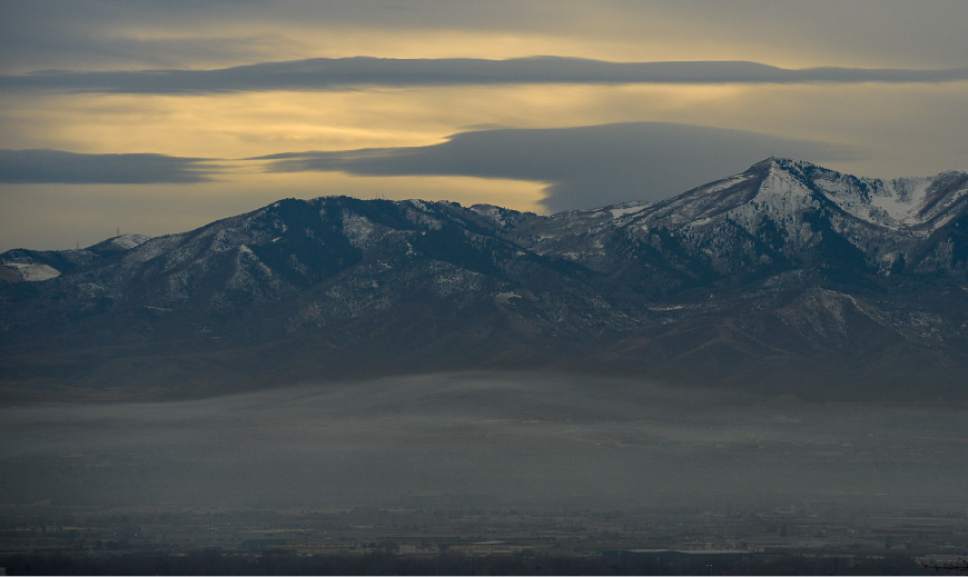This is an archived article that was published on sltrib.com in 2017, and information in the article may be outdated. It is provided only for personal research purposes and may not be reprinted.
Nearly a year after communities on the Wasatch Front failed to attain federal air-quality standards, the Environmental Protection Agency has proposed upgrading their nonattainment status to serious.
Utah's Division of Air Quality now must be more strict about issuing air quality permits and must submit a new plan outlining how it will clean the air in the Logan, Provo and Salt Lake City areas.
Those three Utah regions — as well as Anchorage, Alaska — had failed to come into compliance with federal air quality standards for short-term concentrations of fine particulate pollution, or PM 2.5, by a Dec. 31, 2015 deadline.
Utah's new plan would be due to the EPA by Dec. 31, 2017. Compliance would be expected by Dec. 31, 2019, according to the EPA's rule, which was published in the Federal Register on Friday.
The span before that first deadline, said Bryce Bird, director of the Utah Division of Air Quality, is a bit shorter than the usual 18 months. But his division has already begun work on the new plan, he said, and probably won't need additional time.
"It is something that is reasonable, something we have been working toward, and so we will work to make that deadline," Bird said.
Matt Pacenza, executive director of environmental group HEAL Utah, said he thought the proposal and its short deadline was good news for Utah's environment,
"The sooner Utah gets to work, the better," he said.
But Pacenza said he was concerned about the fact that the EPA will be under the direction of President-elect Donald Trump's appointee — Oklahoma Attorney General Scott Pruitt — when Utah submits its new plan for review.
Bird had other concerns. On the Wasatch Front, fine particulate pollution builds up in the winter, during inversion episodes that occur during long periods of cold, quiescent weather. Addressing the problem, he said, is going to require taking measures that respond to the weather forecast.
But the EPA's criteria for implementation plans don't give states credit for these kinds of responsive measures, Bird says, which means Utah "might have to go outside requirements to get a plan that actually works."
For example, Bird said, the state is planning an initiative next month to encourage major Utah businesses to give their employees more flexibility when a potential inversion is forecast. The employer might permit telecommuting on these days, or adopt a workplace schedule that doesn't require everyone on staff to arrive at the same time.
"We can't take credit for that," he said, "but it could do a lot to improve the pollutants that lead to high levels during our inversions."
That Utah failed to make the original December 2015 deadline wasn't a huge surprise, Bird said. Modeling from the state's original implementation plan indicated that compliance by that time was unlikely.
But those same models projected compliance by 2019 if measures to control pollution remained in place.
In fact, Bird said, much of Utah might have met the 2015 deadline had it not been for an extended inversion in 2013. Compliance is determined on a three-year basis, and 2013 was a particularly bad year.
But in 2014, 2015 and 2016, northern Utah remained below the EPA's 24-hour limits for fine-particulate pollution, except for Salt Lake City and northern Provo, Bird said.
Population growth, he said, could pose a challenge over the next several years. But he said he believed that by implementing new pollution controls, Utah will be able to counteract the expected increase in emissions and achieve compliance by 2019.
The EPA's Friday proposal also noted that seven other PM 2.5 nonattainment areas — none in Utah — met the 2015 deadline.
The agency will accept public comment on the proposal until Jan. 17.
Twitter: @EmaPen Public Comment Period
Comments on the EPA's proposal to reclassify Utah's PM 2.5 nonattainment status will be accepted through Jan. 17:
• Online at http://www.regulations.gov. Instructions are available on the website.
• Via email to a-and-r-Docket@epa.gov, attention Docket ID No. EPA-HQ-OAR-2016-0515.
• Via fax, at 202-566-9744, attention Docket ID No. EPA-HQ-OAR-2016-0515.
• Through the mail:
Environmental Protection Agency, EPA Docket Center
(EPA/DC), Mailcode: 28221T, 1200 Pennsylvania Ave., NW, Washington, DC., 20460
Attention Docket ID No. EPA-HQ-OAR-2016-0515.



